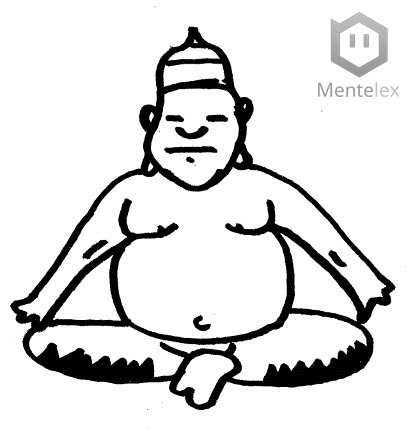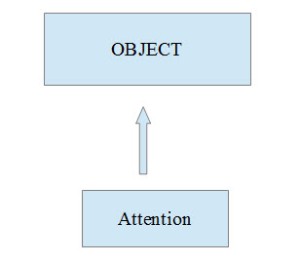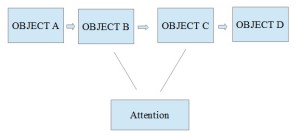
SCIENCE & MINDFULNESS MEDITATION
Mindfulness Meditation Part 1
With its origin in Buddhist meditation, Mindfulness can be defined as a meditation technique that focus on attention control and on increasing awareness over the moment-by-moment experience. In recent years, Mindfulness has been applied as a therapy approach in psychology, with positive results in stress reduction, anxiety symptomatology and emotional regulation (Arch at al., 2006; Bishop et al., 2004).
http://www.youtube.com/watch?v=pHNyCAJXUXE
SCIENCE & MINDFULNESS MEDITATION
- Mindfulness training allows people to have more adaptative responses among negative stimuli (Arch, et al., 2006).
- Mindfulness contributes to a better emotion regulation (Arch et al., 2006).
- Mindfulness technique is a process of regulating attention that focus on moment-by-moment awareness (Bishop et al., 2004).
HOW TO MEDITATE
- SEAT ALONE
- FOCUS ON EXPIRATION
- STARTS WITH FIVE MINUTS EVERY DAY
- DON´T TRY TO PUT YOUR MIND IN SILENCE: IT´S IMPOSSIBLE!!
References
Arch, J. J., & Craske, M. G. (2006). Mechanisms of mindfulness: Emotion regulation following a focused breathing induction. Behaviour Research and Therapy, 44(12), 1849-1858. doi:10.1016/j.brat.2005.12.007
Bishop, S. R., Lau, M., Shapiro, S., Carlson, L., Anderson, N. D., Carmody, J., … Devins, G. (2004). Mindfulness: A Proposed Operational Definition. Clinical Psychology: Science and Practice, 11(3), 230–241. doi:10.1093/clipsy.bph077
Mindfulness Meditation Part 2
Mindfulness can be conceptualized as a process of self-regulation of attention to the present moment, understood as curiosity, openness and acceptance. This type of attention requires sustained attention and flexibility in the ability to orient attention.  The focus of attention varies constantly because they can be emotions, thoughts, and actions. It also requires the ability to inhibit elaborative thought process. In depressive states is normal that ruminating thinking prevails among other mental states. This kind of thinking is not effective to resolve the discrepancy between the current state and the desired mental state. Mindfulness helps reduce dysphoric ruminative thinking spiral. According to Kabat-Zinn (1990), this process of mindfulness brings a certain quality to the focus on the experience of the present moment-to-moment. This experience of the present moment is an observation that does not pass through the filter of beliefs, assumptions and expectations. Mindfulness is a process that develops a decentralized view of emotions and thinking in terms of subjectivity and transience.
The focus of attention varies constantly because they can be emotions, thoughts, and actions. It also requires the ability to inhibit elaborative thought process. In depressive states is normal that ruminating thinking prevails among other mental states. This kind of thinking is not effective to resolve the discrepancy between the current state and the desired mental state. Mindfulness helps reduce dysphoric ruminative thinking spiral. According to Kabat-Zinn (1990), this process of mindfulness brings a certain quality to the focus on the experience of the present moment-to-moment. This experience of the present moment is an observation that does not pass through the filter of beliefs, assumptions and expectations. Mindfulness is a process that develops a decentralized view of emotions and thinking in terms of subjectivity and transience.
http://www.youtube.com/watch?v=zt1jjnmkr0E
SCIENCE & MINDFULNESS MEDITATION
- Mindfulness increases the ability to have cognitive flexibiliy (Lee & Orsillo, 2014).
- It is easy to inhibit maladaptive thoughts after mindfulness training (Hoffmann, et al., 2010).
- Mindfulness training is effective on reduction of anxiety and depressive symptoms among different and several pathologies (Hoffmann, et al., 2010).
- Cognitive flexibility appears to be inclusive of both inhibitory and switching involved on breathing and focus attention processes (Lee & Orsillo, 2014).
HOW TO MEDITATE
- SEAT WELL. WE DON´T SLEEP.
- FOCUS ON RETURNING ATTENTION TO EXPIRATION.
- STAY WITH FIVE MINUTS EVERY DAY: 5 MINUTS COULD BE HELL!!
- DON´T TRY TO CONTROL YOUR THOUGHTS. IT´S NORMAL THAT YOUR ATTENTION JUMPS BETWEEN THOUGHTS AND YOUR EXPIRATION.
Kabat-Zinn, J. (1990). Full catastrophe living: Using the wisdom of your mind to face stress, pain and illness. New York: Dell.
Hofmann, S. G., Sawyer, A. T., Witt, A. A., & Oh, D. (2010). The effect of mindfulness-based therapy on anxiety and depression: A meta-analytic review. Journal of Consulting and Clinical Psychology, 78(2), 169-183.
Lee, J. K., & Orsillo, S. M. (2014). Investigating cognitive flexibility as a potential mechanism of mindfulness in Generalized Anxiety Disorder. Journal of Behavior Therapy and Experimental Psychiatry, 45(1), 208-216. doi:10.1016/j.jbtep.2013.10.008
Mindfulness Meditation Part 3
In the study of Jain et al., 2007, they compared two brief (1 month) stress-reduction intervention. One based on relaxation and the other based on mindfulness meditation. Both therapies were successful in alleviating overall psychological distress.
Positive states of mind are defined by focused attention, productivity, responsible care taking, restful response, sharing sensuous nonsexual pleasure and sensuous sexual pleasure (Adler et al., 1998). Stress may impair capacities to experience positives states of mind.
Jain et al., also demostrated that the mindfulness meditation group reduced effectively rumination and distraction compared to the relaxation group. Teasdale et al., 1995, demostrate that mindfulness meditation interventions may prevent depressive relapse by reducing rumination. Reducing rumination could be included as a cognitive tool in therapies.
HOW TO MEDITATE
- SEAT IN FRONT OF A WHITE WALL.
- FOCUS ON ENLARGING THE EXPIRATION.
- STAY ON THE FIVE MINUTES EVERY DAY: IF TIME GOES SLOWLY, KEEP CALM, IT’S ONLY A MIRAGE.
- DON’T TRY TO DO NOTHING MORE. MEDITATION IT’S EASY!!
References:
Adler, N. E., Horowitz, M., Garcia, A., & Moyer, A. (1998). Additional validation of a scale to assess positive states of mind. Psychosomatic Medicine, 60(1), 26-32.
Jain, S., Shapiro, S. L., Swanick, S., Roesch, S. C., Mills, P. J., Bell, I., & Schwartz, G. E. R. (2007). A randomized controlled trial of mindfulness meditation versus relaxation training: Effects on distress, positive states of mind, rumination, and distraction. Annals of Behavioral Medicine, 33(1), 11-21. doi:10.1207/s15324796abm3301_2
Teasdale, J. D., Segal, Z., & Williams, J. M. (1995). How does cognitive therapy prevent depressive relapse and why should attentional control (mindfulness) training help? Behaviour Research and Therapy, 33(1), 25-39.
Mindfulness Meditation Part 4
SCIENCE & MINDFULNESS MEDITATION
In mindfulness practice, we have found two main attentional mechanisms. The first one is centered on focused attention. The exercise consist to focus your attention to an object, usually the object is your breathing.
The second one is centered on open attention. The exercise consists of an observation of the mental flow but without any identification; as if you were a mental observer of your own ideas and feelings.
In the study of Moore et al., 2012, they demonstrate that regular and brief mindfulness meditation practice improves the capacity of self-regulation of attention. Meditation group perform better on the Stroop test task. Reaction time was better in the meditation group than in the control group. We hypothesized that working of sustained attention could improve inhibition of response.
HOW TO MEDITATE
- SEAT WITH THE BOTTON OF THE FOOT TOTALLY IN CONTACT WITH THE FLOOR.
- FOCUS ON TO EXPIRATE WITH YOUR MOUTH.
- STAY WITH FIVE MINUTS EVERY DAY: MORNING? AFTERNOON? IT DOESN´T MATTER!! JUST DO IT.
- DON´T TRY TO EVALUATE YOUR PROGRESSSION. IT´S NORMAL THAT NOTHING HAPPENS.
References:
Jha, A. P., Krompinger, J., & Baime, M. J. (2007). Mindfulness training modifies subsystems of attention. Cognitive, Affective, & Behavioral Neuroscience, 7(2), 109-119. doi:10.3758/CABN.7.2.109
Moore, A., Gruber, T., Derose, J., & Malinowski, P. (2012). Regular, brief mindfulness meditation practice improves electrophysiological markers of attentional control. Frontiers in Human Neuroscience, 6. doi:10.3389/fnhum.2012.00018
Mindfulness Meditation Part 5
There are two styles of meditation. The first, is to try to focus our attention on a single object. The second is to monitor our attention in a  moment-by-moment experience. Both of them could be viewed as an attentional training and a possible way to cultivate our well-being. Focused attention meditation is not a passive work. You must constantly and actively monitor the quality of your attention. You must constantly and actively monitor the quality of your attention. In our normal lives, attention jumps from an object to object, without any work. Monitoring implies to recognize that attention wanders away. Then, you must consciously refocus your attention to the chosen object.
moment-by-moment experience. Both of them could be viewed as an attentional training and a possible way to cultivate our well-being. Focused attention meditation is not a passive work. You must constantly and actively monitor the quality of your attention. You must constantly and actively monitor the quality of your attention. In our normal lives, attention jumps from an object to object, without any work. Monitoring implies to recognize that attention wanders away. Then, you must consciously refocus your attention to the chosen object.
SCIENCE & MINDFULNESS MEDITATION
There are different and specific neural systems associated with meditation. These systems are the neural network for some cognitive functions:
- Conflict monitoring (cingulate cortex, prefrontal cortex).
- Selective attention (temporoparietal junction, prefrontal cortex).
- Sustained attention (right frontal cortex; prefrontal cortex).
HOW TO MEDITATE
- SIT UP WITH YOUR BACK “STRAIGHT RIGHT”.
- FOCUS, FOCUS, FOCUS ON EXPIRATION.
- STAY WITH FIVE MINUTES EVERYDAY: AT LEAST THREE MONTHS!!
- DON’T TRY TO GET THE PRIZE. IT’S NOT A COMPETITION WITH YOURSELF.
References:
Corbetta, M., & Shulman, G. L. (2002). Control of goal-directed and stimulus-driven attention in the brain. Nature Reviews Neuroscience, 3(3), 201-215. doi:10.1038/nrn755
Posner, M. I., & Rothbart, M. K. (2007). Research on Attention Networks as a Model for the Integration of Psychological Science. Annual Review of Psychology, 58(1), 1-23. doi:10.1146/annurev.psych.58.110405.085516
Weissman, D. H., Roberts, K. C., Visscher, K. M., & Woldorff, M. G. (2006). The neural bases of momentary lapses in attention. Nature Neuroscience, 9(7), 971-978. doi:10.1038/nn1727
Mindfulness Meditation Part 6
SCIENCE & MINDFULNESS MEDITATION
Mindfulness Based Stress Reduction (MBSR; Kabat-Zinnn, 2003) is a meditation-based treatment program applied to diverse clinical conditions. It seems that MBSR improves attention, nonjudgmental attitude and focus on the present.
Nonjudgmental attitude may be related to an emotional response. Emotional resonses are linked to the emotional brain,  particularly with the amygdala. It has been demonstrate that the response of the amygdala to negative distractors in a sustained attention task is better in experienced meditators (Brefczynski-Lewis et al., 2007). In normal life, negative distractors tend to focus our attention on the future more than in the present. For example, if I am studying for an exam, my fear of fail on the exam, disrupts my sustained attention on what I am learning. At the same time, my attention jumps from the present to the future.
particularly with the amygdala. It has been demonstrate that the response of the amygdala to negative distractors in a sustained attention task is better in experienced meditators (Brefczynski-Lewis et al., 2007). In normal life, negative distractors tend to focus our attention on the future more than in the present. For example, if I am studying for an exam, my fear of fail on the exam, disrupts my sustained attention on what I am learning. At the same time, my attention jumps from the present to the future.
There is a big difference on studying for achieve or pass the test, and studying for learning. In the first condition, you will need a big attentional effort because your motivation is clearly in the future and not in the process itself. The process itself always happens in the present. It can not always be ensured that you will pass the exam with a mindful brain.
HOW TO MEDITATE
- TRY ON SUNSET.
- TRY WITH FRIENDS.
- DO NOT TRY WITH RELAXATION MUSIC.
- DO NOT TRY IN YOUR BED, BEFORE GOING TO SLEEP.
- YOU NEED TO MASTER THE EXERCISE BEFORE TRYING IT IN VERY BAD DAYS.
References:
Brefczynski-Lewis, J. A., Lutz, A., Schaefer, H. S., Levinson, D. B., & Davidson, R. J. (2007). Neural correlates of attentional expertise in long-term meditation practitioners. Proceedings of the National Academy of Sciences, 104(27), 11483-11488. doi:10.1073/pnas.0606552104
Jensen, C. G., Vangkilde, S., Frokjaer, V., & Hasselbalch, S. G. (s.d.). Mindfulness training affects attention—Or is it attentional effort? Journal of Experimental Psychology: General, 141(1), 106-123. doi:http://dx.doi.org/10.1037/a0024931
Kabat-Zinn, J. (2003). Mindfulness-based stress reduction (MBSR). Constructivism in the Human Sciences, 8(2), 73-107.



